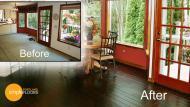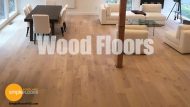Many homeowners focus on aesthetics and durability when considering home improvements. However, indoor air quality (IAQ) is just as crucial for a healthy living environment. The type of flooring installed in a home plays a significant role in maintaining good air quality. Certain flooring materials can improve or degrade the air we breathe, making it essential to choose wisely.
 In recent years, there has been a growing awareness of the connection between flooring and health. According to the American Lung Association, indoor air can be 2 to 5 times more polluted than outdoor air. Various pollutants can accumulate indoors, including dust, allergens, and volatile organic compounds (VOCs). Thus, flooring options should be evaluated for style and their impact on air quality.
In recent years, there has been a growing awareness of the connection between flooring and health. According to the American Lung Association, indoor air can be 2 to 5 times more polluted than outdoor air. Various pollutants can accumulate indoors, including dust, allergens, and volatile organic compounds (VOCs). Thus, flooring options should be evaluated for style and their impact on air quality.
Understanding VOCs and Their Sources
Volatile organic compounds (VOCs) are organic chemicals that evaporate at room temperature. They can be emitted by various household products, including paints, varnishes, cleaning supplies, and even some types of flooring. For instance, laminate flooring can contain high levels of VOCs due to the adhesives and finishes used during manufacturing. Transitioning to low-VOC flooring options can significantly reduce these harmful emissions.
Moreover, a study published in the journal Environmental Science & Technology revealed that certain types of vinyl flooring can significantly contribute to poor indoor air quality due to VOC emissions. The findings indicate that better flooring choices can enhance indoor air environments. Homeowners are encouraged to consider options that are certified low-VOC or phthalate-free to minimize air quality issues.
Evaluating Different Flooring Materials
Different flooring materials have varying effects on indoor air quality. For instance, carpets can act as a reservoir for dust, mold, and allergens. Myriad studies, including one by the American Journal of Public Health, have shown that carpets while providing comfort, can harbor pollutants that might affect health. Therefore, people with asthma or allergies should carefully evaluate their choice of carpet.
On the other hand, hard surface flooring options—such as tile, hardwood, and luxury vinyl—are generally better for air quality. These materials do not trap dust and allergens like carpets do. Tile flooring, in particular, can help reduce allergens because it is easy to clean and does not retain dust.
Carpet vs. Hard Surface Flooring
When comparing carpet to hard surface flooring, the impact of the differences in air quality becomes apparent. Carpet fibers can collect dirt, dust, and pet dander, exacerbating allergy symptoms. In fact, research indicates that rooms with carpets may have significantly higher levels of dust mite allergens. Transitioning to hard surface flooring can greatly improve air quality by reducing these allergens.
Nevertheless, it is crucial to maintain hard surface floors effectively. Regular sweeping, vacuuming, and mopping prevent the build-up of pollutants and allergens. Moreover, hard floor surfaces tend to be more resistant to stains and moisture, which can also affect air quality over time. Homeowners should consider how each type of flooring will be cleaned and maintained when deciding.
Importance of Air Quality in Health
Poor indoor air quality can contribute to various health issues, including respiratory problems and allergies. In fact, a study by the Harvard T.H. Chan School of Public Health found that improved air quality is linked to better overall health outcomes. Thus, selecting the right flooring material is essential to creating a healthy home.
In addition to respiratory problems, poor air quality can lead to headaches, fatigue, and even cognitive issues. Transitioning to healthier flooring options such as tile, hardwood, or low-VOC laminate can improve the living environment. Families, especially those with children or elderly members, should prioritize indoor air quality in their flooring decisions.
Selecting Air Quality-Friendly Flooring Options
When deciding on flooring materials, look for products that are labeled as low-VOC or have undergone rigorous testing for indoor air safety—organizations such as the Carpet and Rug Institute (CRI) rate carpets based on their emissions. Additionally, the GREENGUARD Certification program offers guidelines on products that contribute to healthier indoor air quality.
Additionally, consider natural flooring types such as bamboo and cork. These materials are not only sustainable but also hypoallergenic. By choosing eco-friendly flooring options, homeowners can make a significant contribution to indoor air quality.
Long-Term Maintenance and Its Role in Air Quality
Even the best flooring materials require maintenance to uphold air quality. Regular cleaning is essential to prevent dust and allergens from accumulating. For carpets, thorough vacuuming with a HEPA filter is recommended to trap fine particles and allergens effectively.
For hard surfaces, consistent sweeping and damp mopping will help maintain their appearance and cleanliness. Additionally, consider using sealed, waterproof flooring options for moisture-prone areas, such as kitchens and bathrooms, to avoid mold growth.
Furthermore, an air quality monitor should be installed to assess the levels of indoor pollutants. By being proactive about maintenance and air quality monitoring, homeowners can significantly enhance their living environment.
Making Informed Flooring Choices
Choosing the right flooring can profoundly impact indoor air quality. By evaluating the types of materials available, homeowners can create healthier living spaces. Transitioning to low-VOC, hard surface flooring options can help reduce allergens while enhancing overall aesthetics.
When selecting flooring, Portland homeowners and residents of nearby areas should consider both style and health. As pollution levels rise in many urban environments, the connection between flooring choices and air quality becomes ever more important. Making informed decisions contributes to the beauty of your home and the health of those who live in it. For more information on flooring options, consult local experts to guide you in making the best choices for your household.







